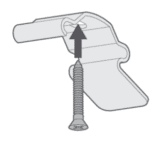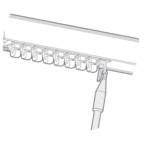Learn how to measure for Vertical Blinds with our easy-to-follow guides and get that perfectly fitted window covering made-to-measure to your window size.
Table of Contents
ToggleHow to measure for Vertical Blinds
What you’ll need:
- steel measuring tape
- pencil to mark your measurements
- ladder (if necessary) for tall windows or patio doors
Standard windows – recess fitting
Measure the full width and height of the recess, and we will make the appropriate deductions to ensure a perfect fit.
◾ Measure in 3 places for both the width and the drop, and use the smallest measurement
◾ Do not make any deductions – we’ll deduct 10mm from the width and 15mm from the drop to ensure your blind fits perfectly.
Check that your recess is deep enough to fit the Blind into, also bearing in mind any obstructions such as handles. The minimum depth needed for a Vertical Blind is 75mm.
Standard window – exact fitting
Measure the full width and height of the recess and add a little extra to the top and each side. We will make the Blind to the size you specify with no deductions.
How much extra space should you add?
To minimise light leakage, we recommend that the blind overlaps the window recess by at least 70mm at the top and 50mm on each side. The overlap at the bottom of the Blind is a matter of personal choice, but please take into account obstacles such as radiators.
Top Tip: If you are replacing an existing Blind with one of the same sizes, measure the Blind (including its fittings) and specify the exact fitting.
Bay windows, half-bays & L-shaped windows
We have some handy guides already put together, especially for Vertical Blinds in bay windows. Click on the links below to take a look.
Angled bay windows
Click here for our handy guide.
Square bay windows
Click here for our handy guide.

How to install Vertical Blinds
Fitting your Vertical Blinds is easier than it seems. Watch our how-to video, grab your tools and follow the instructions below.
What you’ll need:
◾ pencil
◾ power drill
◾ screwdriver
◾ scissors
◾ ladder (if necessary)
We recommend watching our how-to-install video guide first.
Fitting the brackets
There are two types of brackets for vertical blinds, each of which offers a different method of installation:
Top-Fixing

Use the single hole in the top of the bracket to fix the lintel.
Face-Fixing

Use two screws through the back plate to mount it onto a facing surface (a wall or window frame).
Note that the position of the outermost brackets should be at least 5cm away from the ends of the rail, with any other brackets evenly distributed across the width.
If you’re using top-fix brackets, make sure that you mount them at least 7.5cm in front of either the window frame or any protruding vents or hands, if there are any. This allows space for the louvres to turn open and close.
Fitting the Blind
Top-Fixing

Situate the front lip of the headrail into the front of the bracket. Lift the back of the headrail and push up firmly to secure the back of the rail into the bracket.
Face-Fixing

Situate the back lip of the headrail into the back hook of the bracket. Lift the front of the headrail, so it’s level, then tighten the screw in the front of the bracket to secure the rail in place.
Hanging the louvres
Before hooking the louvres on the rail, use the control wand to turn the hooks so that they all face side on. This makes it far quicker to hook the louvres on and ensures that the louvres will not clash when you first use the blind.
Hook the louvres onto the rail.

Hook the control wand onto the eyelet at the end of the hooks.

Slide the weight into the pocket at the bottom of the louvre.

Clip the stabilising chain onto the weights, one chain will run along the back, and the second will run along the front. Any excess clips can be cut away – just snip the cord flush to the last clip attached to a weight.

If your Vertical Blind slats have minor creases, allow them to hang. Such creases will hang out after a short period of time.
How to clean your Vertical Blinds
Regular cleaning should be in your practice if you want your Blinds to look new for a long time. Dusting weekly using a feather duster will prevent any build-up of dust. For detailed instructions, visit our Vertical Blinds cleaning guide.




